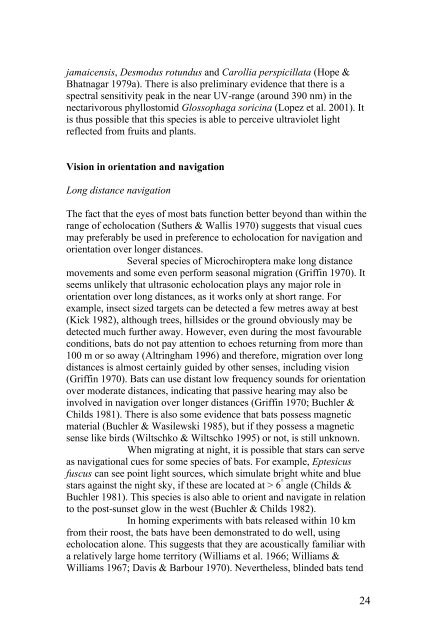Vision in echolocating bats - Fladdermus.net
Vision in echolocating bats - Fladdermus.net
Vision in echolocating bats - Fladdermus.net
Create successful ePaper yourself
Turn your PDF publications into a flip-book with our unique Google optimized e-Paper software.
jamaicensis, Desmodus rotundus and Carollia perspicillata (Hope &<br />
Bhatnagar 1979a). There is also prelim<strong>in</strong>ary evidence that there is a<br />
spectral sensitivity peak <strong>in</strong> the near UV-range (around 390 nm) <strong>in</strong> the<br />
nectarivorous phyllostomid Glossophaga soric<strong>in</strong>a (Lopez et al. 2001). It<br />
is thus possible that this species is able to perceive ultraviolet light<br />
reflected from fruits and plants.<br />
<strong>Vision</strong> <strong>in</strong> orientation and navigation<br />
Long distance navigation<br />
The fact that the eyes of most <strong>bats</strong> function better beyond than with<strong>in</strong> the<br />
range of echolocation (Suthers & Wallis 1970) suggests that visual cues<br />
may preferably be used <strong>in</strong> preference to echolocation for navigation and<br />
orientation over longer distances.<br />
Several species of Microchiroptera make long distance<br />
movements and some even perform seasonal migration (Griff<strong>in</strong> 1970). It<br />
seems unlikely that ultrasonic echolocation plays any major role <strong>in</strong><br />
orientation over long distances, as it works only at short range. For<br />
example, <strong>in</strong>sect sized targets can be detected a few metres away at best<br />
(Kick 1982), although trees, hillsides or the ground obviously may be<br />
detected much further away. However, even dur<strong>in</strong>g the most favourable<br />
conditions, <strong>bats</strong> do not pay attention to echoes return<strong>in</strong>g from more than<br />
100 m or so away (Altr<strong>in</strong>gham 1996) and therefore, migration over long<br />
distances is almost certa<strong>in</strong>ly guided by other senses, <strong>in</strong>clud<strong>in</strong>g vision<br />
(Griff<strong>in</strong> 1970). Bats can use distant low frequency sounds for orientation<br />
over moderate distances, <strong>in</strong>dicat<strong>in</strong>g that passive hear<strong>in</strong>g may also be<br />
<strong>in</strong>volved <strong>in</strong> navigation over longer distances (Griff<strong>in</strong> 1970; Buchler &<br />
Childs 1981). There is also some evidence that <strong>bats</strong> possess mag<strong>net</strong>ic<br />
material (Buchler & Wasilewski 1985), but if they possess a mag<strong>net</strong>ic<br />
sense like birds (Wiltschko & Wiltschko 1995) or not, is still unknown.<br />
When migrat<strong>in</strong>g at night, it is possible that stars can serve<br />
as navigational cues for some species of <strong>bats</strong>. For example, Eptesicus<br />
fuscus can see po<strong>in</strong>t light sources, which simulate bright white and blue<br />
stars aga<strong>in</strong>st the night sky, if these are located at > 6 ° angle (Childs &<br />
Buchler 1981). This species is also able to orient and navigate <strong>in</strong> relation<br />
to the post-sunset glow <strong>in</strong> the west (Buchler & Childs 1982).<br />
In hom<strong>in</strong>g experiments with <strong>bats</strong> released with<strong>in</strong> 10 km<br />
from their roost, the <strong>bats</strong> have been demonstrated to do well, us<strong>in</strong>g<br />
echolocation alone. This suggests that they are acoustically familiar with<br />
a relatively large home territory (Williams et al. 1966; Williams &<br />
Williams 1967; Davis & Barbour 1970). Nevertheless, bl<strong>in</strong>ded <strong>bats</strong> tend<br />
24


